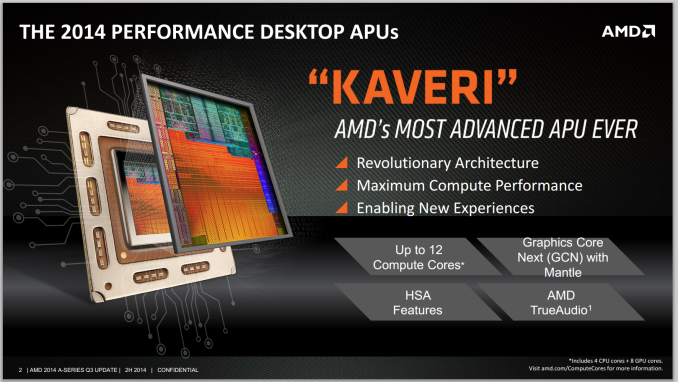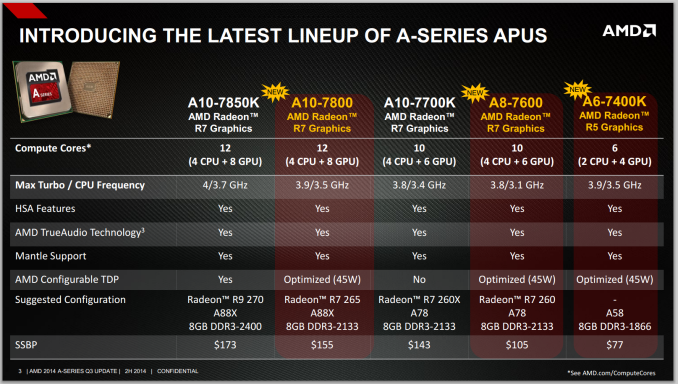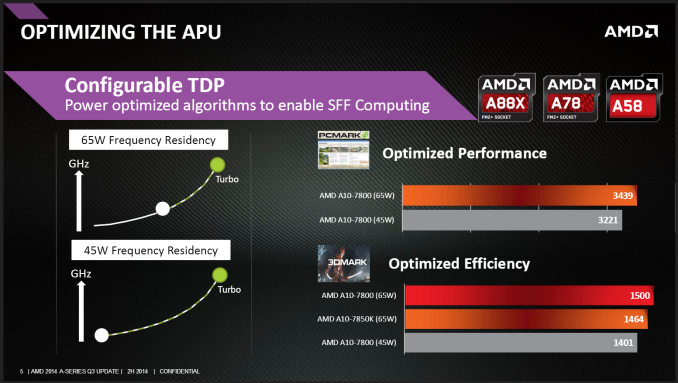AMD Officially Launches 65W/45W Kaveri APUs: The A10-7800, A8-7600 and A6-7400K
Back in January when AMD launched their first Kaveri APUs, we tested the A10-7850K and the A8-7600, with the former being at the top of the product stack featuring two Steamroller modules and 512 GCN cores with a 4.0 GHz turbo frequency. This part, along with the A10-7700K that was also released at the same time, has a nominal TDP of 95W. The interesting element in the mix was the 65W A8-7600, which AMD provided as a sample to review at the time, but was to be released ‘at a future date’. Today is that date, six months after the initial reviews.
AMD’s reason for the delay revolves around the 65W nature of the APUs but also their configurable TDP element. Rather than launch a new APU every two months, they combined all three in an effort to get out this new message that the 65W APUs can all be adjusted to fit within a 45W TDP by reducing the clock speeds.
When we examined the A8-7600 at 45W, we found that the killer application for this APU would be in the integrated graphics segment, where it offered some of the best processor graphics for power consumption on the market. The other two APUs being releases today, the A10-7800 and the A6-7400K, both aim to continue that trend above and below the A8 market.
I am currently waiting for the full specifications for these APUs from AMD, including memory support as well as core counts/frequencies of the processor graphics.
Users will note that the listed price for the A8-7600 has been reduced from the initial review by AMD in order to align the stack better for price against performance. All three new APUs will register as 65W to begin with, and the user will have to enable 45W mode in the BIOS of the motherboard. Enabling the 45W mode corresponds to an ~400-500 MHz drop of full loading frequency while still enabling a high turbo:
AMD quotes a 6-7% drop in performance in PCMark 8 and 3DMark by moving down to the 45W TDP mode, with SFF or low power systems seeing the most benefit.
The technologies that were part of the first Kaveri APU launch are also present with the 65W models, including the Heterogeneous System Architecture (HSA), Unified Memory for both CPU and GPU (hUMA), heterogeneous queuing of kernels (hQ), Graphics Core Next (GCN) with Mantle and AMD TrueAudio.
With the OpenCL support, AMD is keen to express their performance benefits in Adobe Photoshop CC (A10 vs i5), LibreOffice (A8 vs i3) and JPEG Decode (A6 vs Pentium). AMD also points out in its release that PowerDVD 14 is fully supporting HEVC compute via OpenCL on AMD APUs, with also AMD Fluid Motion Video in a later update.
AMD is running a promotion for the A10 series of Kaveri APUs during August through to October – purchase an A10 APU and choose from either a full copy of Thief, Sniper Elite III or Murdered Soul Suspect. This offer will be available in North America, Latin America, EMEA and Asia Pacific/Japan.
We have the A10-7800 APU in for testing, be sure to look out for that review. We have asked for an A6-7400K sample, which allows overclocking, and it will be interesting to see how the single module SKU stacks up against the Pentium CPUs we recently tested.








